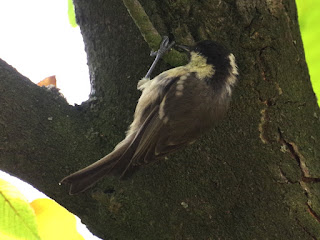The family with three chicks from the Long Water had also come on to the Serpentine, and had advanced some way up it, into the territory of another pair. One of these advanced threateningly ...
... to be met by threats from the other side, including the chicks which copied their parents. Both sides backed off a bit, and peace was restored. There is plenty of fish for everyone.
The other grebe family on the Long Water hasn't been visible for a while. But one of the parents came into view at a considerable distance, and you could just see two chicks.
One of the two Moorhen chicks in the Italian Garden was walking on the weed between the water lilies. You can see how the little bird's enormous feet keep it up. But if it stood still it would sink in.
The five Tufted ducklings dived briskly at the edge of the Serpentine. They are able to do this from the moment they hatch, since their mother doesn't feed them and they have to find their own food. They eat snails, insect larvae and some plants.
While I was filming, Tom took this excellent close-up of one of the ducklings.
A little girl fed Greylag goslings on the edge of the Serpentine. She was giving them healthy birdseed, not the usual white bread which is bad for them. (Yes, her mother did give me permission to use this video.)
Two Greylag goslings got a change from their usual diet in the patch of British wildflowers at the back of the Lido.
The Canadas' mixed brood of 15 goslings were in good shape, and the accidentally adopted Greylag gosling seems to be more at ease. This is the other adopted gosling in the brood, a Canada considerably younger than the others.
A clamour from a horse chestnut tree near Queen's Gate turned out to be from a family of Blue Tits begging to be fed.
An adult Coal Tit with them was looking for insects in the bark.
The male Little Owl was in the upper chestnut tree, which he favours over the nest tree, probably because there is less trouble from Magpies under the thick canopy of leaves.
A clump of ragwort at the edge of the Long Water attracted a Meadow Brown butterfly.










We should transfer the rule of at least Europe to Grebes. They are so sensible and practical: some posturing, a quick assessment of force correlations, followed by a swift decision not to act if nothing will be gained. They are admirable.
ReplyDeleteIndeed. How right the Romans were to take omens from the flight of birds.
DeleteTo be pedantic Ralph, the Meadow Brown is on Ragwort. Ragweed is something completely different. It's a North American plant that's increasing over here as an alien + is a curse to hay fever sufferers. Always enjoy the photos. Fingers crossed for the Tufty chicks!
ReplyDeleteThanks. Changed.
Delete